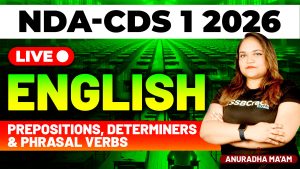A recent class conducted on Trigonometry for the National Defence Academy and Naval Academy (NDA-NA) Exam – Paper I (Maths) provided valuable insights into mastering this important topic. The class was primarily focused on discussing multiple-choice questions (MCQs) from previous years’ exams, as well as analyzing expected questions that could be part of the upcoming NDA-NA exam. This approach gave students a better understanding of the types of questions they may encounter and helped them sharpen their problem-solving skills.
In this blog, we’ll delve into the key takeaways from the class, offer strategies to effectively prepare for the trigonometry section, and conclude with how consistent practice can help you succeed.
Key Takeaways from the Class
The primary focus of the class was on solving MCQs from previous years’ NDA-NA exams, which is an essential step in exam preparation. The discussion covered a wide range of topics that are frequently tested, including:
- Trigonometric Ratios:
- Sine, cosine, tangent, and their reciprocal functions (cosecant, secant, cotangent).
- Application of these ratios in solving angles and lengths in right-angled triangles.
- Degree and Radian Measures:
- Conversion between degrees and radians, which is fundamental to understanding angle measures in trigonometry.
- How questions based on these conversions can appear in the exam and strategies to solve them quickly.
- Trigonometric Functions in Different Quadrants:
- The behavior of trigonometric functions in various quadrants and how their values change depending on the angle.
- A common area of confusion for many students is remembering which trigonometric functions are positive or negative in each quadrant. The class clarified these concepts with the help of examples.
- Values of Trigonometric Functions for Any Angle:
- How to find the values of sine, cosine, and tangent for angles beyond the basic 0°, 30°, 45°, 60°, and 90°.
- The significance of using reference angles and the unit circle to determine these values.
- Compound Angles and C-D Formulas:
- Application of compound angle formulas (used for calculating the sine, cosine, or tangent of the sum or difference of two angles).
- Discussing their use in solving more complex trigonometric problems, which frequently appear in MCQs.
- Trigonometric Equations and Inverse Trigonometric Functions (ITF):
- Solving basic and complex trigonometric equations.
- The introduction and application of inverse trigonometric functions, an important sub-topic where students often face challenges.
By going over the previous years’ MCQs, the class not only helped students get familiar with the type of questions but also focused on improving their speed and accuracy. Understanding how and why certain approaches work was crucial to solving these questions efficiently.
Strategies for Preparing Trigonometry for NDA-NA Exam
To excel in the trigonometry section of the NDA-NA exam, having a clear strategy is key. Here are some strategies discussed during the class that are crucial for effective preparation:
1. Understand the Basics Before Moving to Complex Problems
Trigonometry is a cumulative subject, meaning that each concept builds on the previous one. Ensure that you have a solid grasp of the basics before diving into advanced topics. This includes:
- Understanding the definitions of trigonometric ratios.
- Knowing the unit circle and how angles are represented in different quadrants.
- Familiarizing yourself with the common angles (30°, 45°, 60°, 90°, etc.) and their trigonometric values.
Once these basics are clear, you will find it easier to move on to more complex topics like compound angles and trigonometric identities.
2. Practice MCQs Regularly
As highlighted in the class, solving MCQs from previous years is one of the best ways to prepare for the exam. Regular practice not only helps you retain concepts but also enables you to improve your speed. Start by solving simple questions, then gradually work your way up to more difficult ones.
- Start with topic-specific MCQs: Focus on one concept at a time (e.g., trigonometric ratios, equations, inverse functions).
- Track your mistakes: Identify the topics where you make the most mistakes and revisit those concepts.
3. Focus on Time Management
Time is a critical factor in the NDA-NA exam, and trigonometry problems can be time-consuming if not approached correctly. The class emphasized the importance of time management and solving questions within a time limit. Here are some tips:
- Use shortcuts and tricks where applicable (for example, memorizing standard values of sine, cosine, and tangent can save time during calculations).
- Skip and return: If you find a question taking too much time, skip it and move on. You can return to it later if time allows.
4. Memorize Key Trigonometric Values and Formulas
Certain trigonometric values and formulas frequently appear in exam questions. For instance:
- Know the sine, cosine, and tangent values of common angles (like 30°, 45°, 60°) without needing to derive them each time.
- Memorize key formulas related to compound angles, multiple angles, and trigonometric identities.
The class provided useful tips for organizing these formulas, such as creating flashcards or a formula sheet to review regularly.
5. Use Visualization Techniques
Visualizing problems can significantly improve your understanding and accuracy. During the class, students were encouraged to draw triangles or unit circles when working on trigonometric problems. By sketching the problem, you’ll be able to better understand the relationships between angles and sides.
For example, when working on problems involving angles in different quadrants, visualizing the unit circle and the angle position helps in determining whether the trigonometric function is positive or negative.
6. Review Inverse Trigonometric Functions Thoroughly
Inverse trigonometric functions can be tricky, but they are frequently tested in NDA-NA exams. Focus on understanding:
- The domain and range of inverse functions.
- How inverse trigonometric functions are used to solve trigonometric equations.
This sub-topic often confuses students, so it’s essential to practice various types of problems involving inverse trigonometric functions.
7. Take Mock Tests
Finally, taking mock tests is an invaluable part of your preparation. Mock exams simulate the actual exam environment and help you get accustomed to answering questions under timed conditions. After each test, analyze your performance, review the questions you got wrong, and focus on areas where you can improve.
Conclusion: The Path to Trigonometry Mastery for NDA-NA
The class on Trigonometry for the NDA-NA exam was an insightful and valuable session, providing students with a comprehensive understanding of critical sub-topics. From basic trigonometric ratios to compound angles and inverse trigonometric functions, the class addressed a wide range of topics through the lens of solving multiple-choice questions (MCQs) from previous exams. By emphasizing the importance of practice, time management, and memorization, the session equipped students with practical strategies to approach this section effectively.
Success in the trigonometry section of the NDA-NA exam requires a balance of conceptual understanding, regular practice, and smart test-taking strategies. Whether it’s memorizing formulas or visualizing the problem, being well-prepared will help you tackle trigonometry questions with confidence. With consistent practice, particularly through solving MCQs from past papers, you can sharpen your skills and improve both speed and accuracy.
As you continue your preparation journey, remember to stay focused, review regularly, and take mock exams to gauge your progress. Mastery of trigonometry is within reach, and with the right approach, you can excel in this critical section of the NDA-NA exam.
Good luck!



















